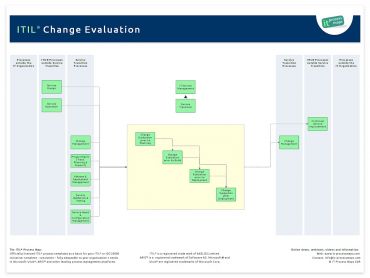ITIL Change Evaluation: Difference between revisions
| Line 25: | Line 25: | ||
[[Image:Itil-change-evaluation.jpg|right|thumb|370px|alt=Change Evaluation ITIL|[https://wiki.en.it-processmaps.com/images/pdf/process_overview_change_evaluation_itil.pdf ITIL Change Evaluation]]] | [[Image:Itil-change-evaluation.jpg|right|thumb|370px|alt=Change Evaluation ITIL|[https://wiki.en.it-processmaps.com/images/pdf/process_overview_change_evaluation_itil.pdf ITIL Change Evaluation]]] | ||
Change Evaluation is called upon by the Change Management process at various points in a Change’s lifecycle to perform a Change assessment. | Change Evaluation is called upon by the Change Management process at various points in a Change’s lifecycle to perform a Change assessment. | ||
The results of a formal Change evaluation are documented in a [[ITIL Change Evaluation#Change Evaluation Report|Change Evaluation Report]], which is thus the main output of the new Change Evaluation process. | |||
The process overview of [[Media:Itil-change-evaluation.jpg|ITIL Change Evaluation]] is showing the most important interfaces (see Figure 1). | The process overview of [[Media:Itil-change-evaluation.jpg|ITIL Change Evaluation]] is showing the most important interfaces (see Figure 1). | ||
| Line 64: | Line 66: | ||
;<span id="Change Manager">Change Manager - Process Owner</span> | ;<span id="Change Manager">Change Manager - Process Owner</span> | ||
:The Change Manager | :The Change Manager controls the lifecycle of all Changes. His primary objective is to enable beneficial Changes to be made, with minimum disruption to IT services. For important Changes, the Change Manager will refer the authorization of Changes to the Change Advisory Board (CAB). | ||
<p> </p> | <p> </p> | ||
Revision as of 18:29, 12 April 2012
<seo metakeywords="change evaluation itil, itil change evaluation" metadescription="Change Evaluation: ITIL process definition - Sub-processes - Terms - Additional information on ITIL Change Evaluation." />

Overview
Objective: ITIL Change Evaluation aims to assess major Changes, like the introduction of a new service or a substantial change to an existing service, before those Changes are allowed to proceed to the next phase in their lifecycle.
Part of: Service Transition
Process Owner: Change Manager
Process Description
In ITIL 2011 a Change Evaluation process has been added, following a clarification in the ITIL® books that the purpose of this process is the evaluation of Major Changes.

Change Evaluation is called upon by the Change Management process at various points in a Change’s lifecycle to perform a Change assessment.
The results of a formal Change evaluation are documented in a Change Evaluation Report, which is thus the main output of the new Change Evaluation process.
The process overview of ITIL Change Evaluation is showing the most important interfaces (see Figure 1).
Sub-Processes
These are the ITIL Change Evaluation sub-processes and their process objectives:
- Change Evaluation prior to Planning
- Process Objective: To assess a proposed major Change before authorizing the Change planning phase.
- Change Evaluation prior to Build
- Process Objective: To assess a proposed major Change before authorizing the Change build phase.
- Change Evaluation prior to Deployment
- Process Objective: To assess a proposed major Change before authorizing the Change deployment phase.
- Change Evaluation after Deployment
- Process Objective: To assess a major Change after it has been implemented, to verify if the Change has met its objectives and to identify any lessons to be learned.
Definitions
The following ITIL terms and acronyms (information objects) are used in ITIL Change Evaluation to represent process outputs and inputs:
- Change Evaluation Report
- Certain types of major Changes, like the introduction of a new service or a substantial change to an existing service, require formal Change evaluations before being authorized. The results of a formal Change evaluation are documented in a Change Evaluation Report. Change evaluations may be used at different points in a Change’s lifecycle, for example before authorizing the Change/Release build or during the Post Implementation Review.
Roles | Responsibilities
- Change Manager - Process Owner
- The Change Manager controls the lifecycle of all Changes. His primary objective is to enable beneficial Changes to be made, with minimum disruption to IT services. For important Changes, the Change Manager will refer the authorization of Changes to the Change Advisory Board (CAB).
| Responsibility Matrix: ITIL Change Evaluation | ||
| ITIL Role | Sub-Process | Change Manager | Other roles involved |
|---|---|---|
| Change Evaluation prior to Planning | A[1] | R[2][3] |
| Change Evaluation prior to Build | A | R[3] |
| Change Evaluation prior to Deployment | A | R[3] |
| Change Evaluation after Deployment | A | R[3] |
Remarks
[1] A: Accountable according to the RACI Model: Those who are ultimately accountable for the correct and thorough completion of the Change Evaluation process.
[2] R: Responsible according to the RACI Model: Those who do the work to achieve a task within Change Evaluation.
[3] In cooperation, as appropriate: Applications Analyst, Technical Analyst, Configuration Manager, Project Manager, Risk Manager and others. Role descriptions...





